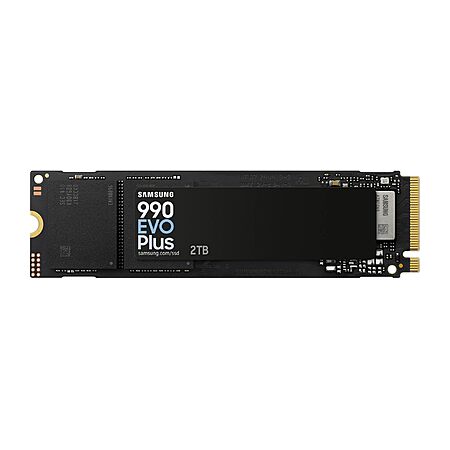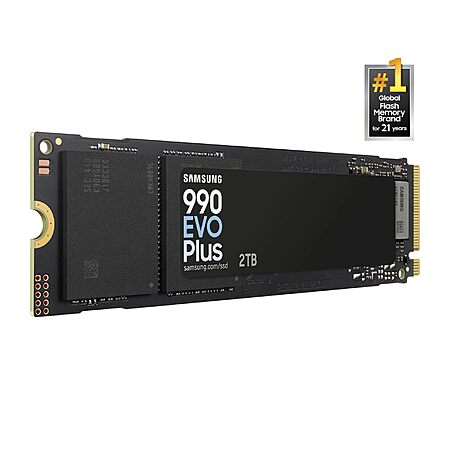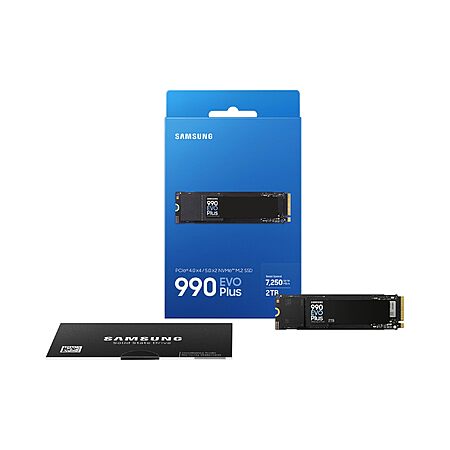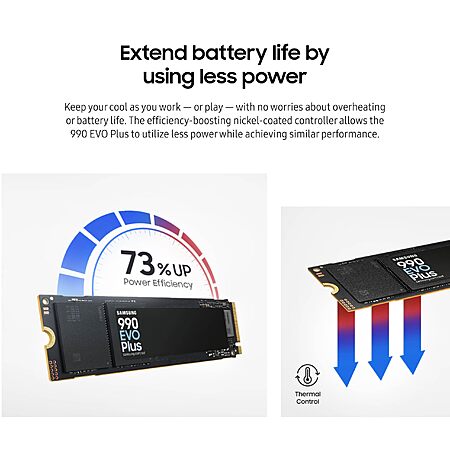Update: This popular deal is still available.
Various Retailers have
2TB Samsung 990 EVO Plus PCIe 5.0 x2 M.2 Internal SSD (MZ-V9S2T0B/AM) on sale for
$119.99.
Shipping is free.
Available from:
Alternatively,
Samsung has for Samsung EDU/EPP members:
2TB Samsung 990 EVO Plus PCIe 5.0 x2 M.2 Internal SSD (MZ-V9S2T0B/AM) on sale for
$113.99.
Shipping is free.
Thanks to Deal Hunter
tDames for sharing this deal.
Specs:
- M.2 2280 Form Factor
- PCIe 5.0 x2 / 4.0 x4 Interface
- Host Memory Buffer (HMB) Cache
- Sequential Reads up to 7250 MB/s
- Sequential Writes up to 6300 MB/s
- Samsung In-House Controller
- Samsung V NAND TLC NAND (V8)
- Endurance (TBW): 1200TB
- AES 256-Bit Data Encryption




Leave a Comment
Top Comments
The controller can thermal throttle when running at too high of a temperature.
This is the function of the heat spreader: to bring the heat *from* the controller to both *cool* the controller and *heat* the NAND.
That's what enclosures on enterprise U.3 NVME drives do. That's why M.2 SSDs ship without installed heatsinks.
The only time a heatsink makes a positive difference is if you're actively writing tons of information to a drive *and* you haven't exhausted the SLC cache space.
That's why SSDs doesn't happen with PS5s as they are basically write-once (limited by your Internet speed.)
Jayz video is simply him running benchmarks that don't represent real-world usage and reporting temperatures with no regard to if it is "good" or "bad"; only "higher number bad."
(Also, random but reminder that TBW values are warranty values with little bearing on actual write endurance. Write endurance would be tested with a JEDEC endurance rating. TBW values are largely a way to attificially segment products.)
37 Comments
Sign up for a Slickdeals account to remove this ad.
Not entirely true, but having one won't be detrimental so it doesn't matter a whole lot one way or the other
They have the same for $114.99 save $5 more
https://www.microcenter
Sign up for a Slickdeals account to remove this ad.
Our community has rated this post as helpful. If you agree, why not thank FozzyFozborne
The controller can thermal throttle when running at too high of a temperature.
This is the function of the heat spreader: to bring the heat *from* the controller to both *cool* the controller and *heat* the NAND.
That's what enclosures on enterprise U.3 NVME drives do. That's why M.2 SSDs ship without installed heatsinks.
The only time a heatsink makes a positive difference is if you're actively writing tons of information to a drive *and* you haven't exhausted the SLC cache space.
That's why SSDs doesn't happen with PS5s as they are basically write-once (limited by your Internet speed.)
Jayz video is simply him running benchmarks that don't represent real-world usage and reporting temperatures with no regard to if it is "good" or "bad"; only "higher number bad."
(Also, random but reminder that TBW values are warranty values with little bearing on actual write endurance. Write endurance would be tested with a JEDEC endurance rating. TBW values are largely a way to attificially segment products.)
The controller can thermal throttle when running at too high of a temperature.
This is the function of the heat spreader: to bring the heat *from* the controller to both *cool* the controller and *heat* the NAND.
That's what enclosures on enterprise U.3 NVME drives do. That's why M.2 SSDs ship without installed heatsinks.
The only time a heatsink makes a positive difference is if you're actively writing tons of information to a drive *and* you haven't exhausted the SLC cache space.
That's why SSDs doesn't happen with PS5s as they are basically write-once (limited by your Internet speed.)
Jayz video is simply him running benchmarks that don't represent real-world usage and reporting temperatures with no regard to if it is "good" or "bad"; only "higher number bad."
(Also, random but reminder that TBW values are warranty values with little bearing on actual write endurance. Write endurance would be tested with a JEDEC endurance rating. TBW values are largely a way to attificially segment products.)
And what is a technical architect Lmao…have seen just about every computer major out there and in every university, including data scientists and AI and have never come across a technical architect.
Our community has rated this post as helpful. If you agree, why not thank wherestheanykey
Lack of DRAM, for starters.
If you're doing a bunch of sustained R/W, there will reach a point in your task where bandwidth dips as cache fills.
This generally happens sooner with HBM than it would if the drive had dedicated DRAM, though it's getting better on some newer NVME controllers.
It probably won't affect your day to day tasks too significantly, but it's worth noting that you can get Gen 4 drives from other manufacturers that have DRAM and match these speeds for around this price. For example, the Crucial T500.
Sign up for a Slickdeals account to remove this ad.
The controller can thermal throttle when running at too high of a temperature.
This is the function of the heat spreader: to bring the heat *from* the controller to both *cool* the controller and *heat* the NAND.
That's what enclosures on enterprise U.3 NVME drives do. That's why M.2 SSDs ship without installed heatsinks.
The only time a heatsink makes a positive difference is if you're actively writing tons of information to a drive *and* you haven't exhausted the SLC cache space.
That's why SSDs doesn't happen with PS5s as they are basically write-once (limited by your Internet speed.)
Jayz video is simply him running benchmarks that don't represent real-world usage and reporting temperatures with no regard to if it is "good" or "bad"; only "higher number bad."
(Also, random but reminder that TBW values are warranty values with little bearing on actual write endurance. Write endurance would be tested with a JEDEC endurance rating. TBW values are largely a way to attificially segment products.)
This is completely dubious.
While NAND does perform better within a certain temperature range, it's disingenuous to neglect that it's a range.
By the same notion that you aren't suggesting that people be able to grill a steak on their drive, nobody is suggesting phase change cooling their drive.
At best, we're talking about a 10° reduction from delta and even less at idle.
Now, tell me, is NAND really that sensitive? Of course not. If it were, none of our storage would work in different climates.
As you admit, the real target of these heatsinks is the NVME controller. Because, yes, even a Gen 3 controller with bad thermals can throttle.
I'm sure I've seen a test floating around where they actually had a separate heatsink just for the controller and found a healthy balance. But, of course, you can't mass produce those, because every layout is different.
But as for why most drives don't come with heatsinks... the real answer is way more obvious. Laptops.
Leave a Comment